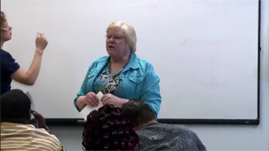Teachers' Domain - Digital Media for the Classroom and Professional Development
User: Preview



Adult education instructors Pat Marshall and Elizabeth Dinkins use real-life examples to demonstrate ratio and to illustrate the relationship between fractions and ratios.
These resources are part of KET’s Teaching Strategies collection.
Differentiation in the ABE Classroom: Teacher Interview: Team Teaching (Video)
Differentiation in the ABE Classroom: Teacher Interview: Worksheets vs. Workbooks (Video)
Differentiation in the ABE Classroom: Teacher Interview: Continuity (Video)
Differentiation in the ABE Classroom: Teacher Interview: Identifying Learning Styles (Video)
Differentiation in the ABE Classroom: Teacher Interview: Encouraging Self-Advocacy (Video)
Differentiation in the ABE Classroom: Teacher Interview: Differentiation of Activities, Part III (Video)
Teaching in the adult education classroom can take many forms. Often, when introducing new concepts, it is helpful to model the concept being taught while learners follow along on worksheets. This approach avoids singling out any learners individually and allows for the reinforcement of writing information as well as hearing it.
Team teaching can also be an effective approach in the adult education classroom. Having more than one teacher allows for more individualized instruction and makes it possible for information to be presented in different formats.
 Loading Standards
Loading Standards